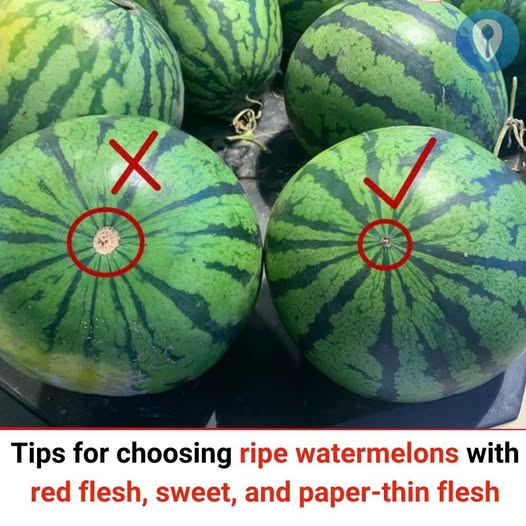4. Tap the Rind for a Hollow Sound
Gently tap the rind with your knuckles. A ripe watermelon will sound deep and resonant , like a drumbeat. A dull, high-pitched sound? It’s likely underripe.
- Science behind it: The hollow sound comes from the air pockets formed as the fruit matures. An unripe melon is denser, producing a muffled tone.
- Caution: Tap gently! Too much pressure can bruise the flesh or create false readings if the melon is damaged.
5. Seek a Thin, Firm Rind
The rind (outer green shell) should feel firm but not rock-hard, and ideally thin and smooth . A thick rind often means less space for the sweet red flesh inside.
- Why it works: A thin rind indicates the melon is mature but not overripe, allowing more room for juicy, tender flesh. Thick rinds suggest older, tougher fruit.
- Test it: Run your fingers along the surface. A ripe melon will have a slight give but shouldn’t feel soft or squishy.
6. Scan for Blemishes and Imperfections
Avoid watermelons with dents, bruises, or cracks . The rind should be smooth and sturdy , with no soft spots or wrinkled patches.
- What to look for:
- A glossy sheen (not dull or matte).
- No cuts, mold, or sunken areas.
- A symmetrical shape—odd bumps or flat sides may indicate uneven growth or damage.
- Pro tip: If buying pre-cut melons, skip those with dry, fibrous flesh. Fresh watermelon should glisten with moisture.
Bonus Tip: The Tendril Test (For Vine-Ripened Melons)
If you’re picking from a farmers’ market or a vine (not pre-harvested), check the tendril where it attached to the vine. A dry, brown tendril means the melon is ripe and ready. A green tendril suggests it was harvested too soon.
Putting It All Together: Your Ripe Watermelon Checklist
When shopping, follow this quick guide:
- Field spot is creamy yellow, not green or white.
- Rind color is rich and uniform.
- Weight feels substantial in your arms.
- Tap test gives a deep, hollow tone.
- Rind thickness is firm but not overly thick.
- Surface texture is smooth and unblemished.
Common Pitfalls to Avoid
- Avoid overly large melons: Smaller to medium-sized ones often have more concentrated flavor.
- Don’t rely on size alone: A small melon can be just as sweet as a massive one.
- Skip the refrigerator bins: Cold storage dulls flavor. Store whole melons at room temperature until cut.
Choosing a ripe watermelon is part science, part intuition. By combining visual cues, sound tests, and a little physical intuition, you’ll unlock the secrets of summer’s sweetest fruit. With these tips, you’ll never again settle for a bland, watery melon. So next time you’re in the produce aisle, channel your inner watermelon whisperer and enjoy the rewards of a perfectly chosen fruit.

